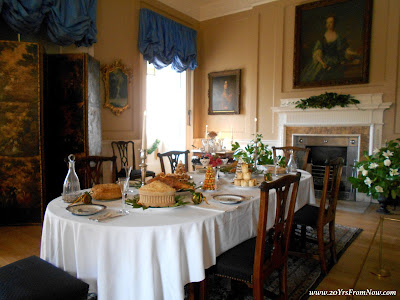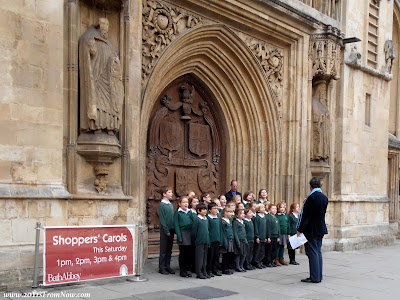We spent about two hours at this museum, wandering through the various exhibits that begin inside and eventually deliver visitors to the various levels (including deep below street level) of this amazingly preserved Roman site.
Volunteers donning Roman costumes made the trip back in time seem all the more authentic. Life expectancy, even for the privileged, was at the best mid-thirties and I found it interesting the head priest stationed here in Bath lived to the ripe old age of 76. Perhaps he had the best gig of all - certainly better than the emperor himself!
This is where the hot spring originates. The Romans did not bath in this next section as this room was for the Goddess' use only. During recent times, however, the water in the Sacred Spring was flooded (up to the brown line) so that Victorians could soak in its healthy benefits. Doctors of the time often prescribed drinking the water as well. Modern analysis of its contents prove it has an extremely high mineral count and visitors are encouraged to try it. We took a sip from the fountain for good measure and while it was slightly warm it had an agreeable taste.
Built between 1767-74 by John Wood the Younger this crescent of thirty stone houses is in the Palladian design. What's interesting is these were intended to be rental holiday homes rather than permanent abodes. One man, however, Henry Sandford, loved it so much he rented Number 1 (shown below) from 1776 until his death in 1796.
It is now a museum and once again we learned a few interesting tidbits about the Georgian way of life. I was rather envious of this group of school children. Not only did they get to visit the museum, but they donned period costumes during their visit. Although it wasn't all fun and games as I overheard one little girl complain about how difficult it was to climb the stairs in a long dress. ;-)
Each room is decorated as it may have been during the period when Henry Sandford lived here.
 |
| The Study |
 |
| Dining Room |
 |
| Lounge |
 |
| Bedroom |
 |
| Guest Bedroom |
 |
| Breakfast Room |
The kitchen is in the basement. The low, curved ceiling illustrates this was not designed to impress, but was solely functional and reserved for the staff.
For this reason many wore wigs (that were lice infested) while others glued narrow strips of mouse fur on their face as eye brows. And there was no shortage of mice as there were dozens of traps in the kitchen to catch the little rodents. Plus, bathing was frowned upon and viewed as dangerous to one's health. Life in the Georgian times was not quite as glamorous as books and movies suggest.
Modern day Bath, however, is a delight. We spotted this group of visitors touring the city in a horse drawn carriage.
Just to the left of the carriage is the river. What a view!
No visit to Bath, however, would be complete without a pub. We found the Coeur de Lion down a small alleyway. It is dubbed as Bath's smallest pub and dates back to 1749. While it is tiny we managed to grab an upstairs table and enjoyed a delicious, tasty lunch.
The mineral content of the Bath spa may have its heath merits, but we prefer a Guinness! Cheers!




























